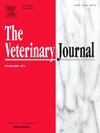Vatinoxan增加用美托咪定-美沙酮-异丙酚-异氟醚麻醉的犬的微循环,用于前列腺前阉割-一项随机临床研究。
IF 3.1
2区 农林科学
Q1 VETERINARY SCIENCES
引用次数: 0
摘要
我们研究了vatinoxan(一种外周选择性α - 2-肾上腺素受体拮抗剂)对前列腺前阉割麻醉犬口腔黏膜和睾丸表面微循环的影响。17只健康的私人养狗随机接受两种肌肉注射治疗:美托咪定0.3mg/m2 +美沙酮0.3mg/kg (MM)或MM +瓦替诺珊6mg/m2 (ZM)。然后用异丙酚和异氟醚麻醉狗。记录心率(HR)和平均动脉压(MAP),并用激光多普勒血流(LD-Flow)和组织血红蛋白氧饱和度(tissue - hbo2)反射光谱相结合的实时混合技术定量微循环变量。在手术过程中测量口腔黏膜和暴露的睾丸表面。数据分析采用Wilcoxon秩和检验和Spearman相关检验。ZM组狗的整体微循环明显更高:MM和ZM的LD-Flow中位数(范围)分别为64(21 - 461)和297(77 - 1558)灌注单位(p < 0.001),而MM和ZM的Tissue-HbO2分别为71(46 - 93)%和88 (73 - 100)% (p < 0.001)。两种治疗均未出现低血压(MAP < 60mmHg)。HR与LD-Flow和Tissue-HbO2呈正相关(p < 0.001), MAP呈负相关(p < 0.001)。总之,口腔黏膜微循环的实时评估很容易,并且可以作为监测镇静和麻醉犬组织氧输送的有价值的补充。Vatinoxan明显改善了美托咪定-美沙酮预用药和异丙酚和异氟醚麻醉的健康犬的微循环。本文章由计算机程序翻译,如有差异,请以英文原文为准。
Vatinoxan increases microcirculation in dogs anaesthetised with medetomidine-methadone-propofol-isoflurane for prescrotal castration – A randomized, clinical study
We investigated the impact of vatinoxan, a peripherally selective alpha2-adrenoceptor antagonist, on oral mucosal and testicular surface microcirculation in dogs anaesthetised for prescrotal castration. Seventeen healthy, privately-owned dogs were randomly allocated to receive one of two intramuscular treatments: medetomidine 0.3 mg/m2 + methadone 0.3 mg/kg (MM) or MM + vatinoxan 6 mg/m2 (ZM). The dogs were then anaesthetised with propofol and isoflurane. Heart rates (HR) and mean arterial pressure (MAP) were recorded and microcirculatory variables quantified with real-time hybrid technology combining laser Doppler flow (LD-Flow) and reflectance spectroscopy for tissue haemoglobin oxygen saturation (Tissue-HbO2). Measurements were obtained from both the oral mucosa and the exposed testicular surface during the procedure. Data were analysed with Wilcoxon’s Rank Sum and Spearman correlation tests. Overall microcirculation was significantly higher for dogs in the ZM group: the median (range) for LD-Flow was 64 (21 – 461) and 297 (77 – 1558) perfusion units for MM and ZM (p < 0.001), whereas Tissue-HbO2 was 71 (46 – 93) for MM and 88 (73−100) % for ZM, respectively (p < 0.001). No hypotension (MAP < 60 mmHg) was noted after either treatment. Moreover, HR was positively (p < 0.001), and MAP negatively (p < 0.001) associated with LD-Flow and Tissue-HbO2. In conclusion, real-time assessment of oral mucosal microcirculation was easy and could be a valuable addition for monitoring tissue oxygen delivery in sedated and anaesthetised dogs. Vatinoxan markedly improved microcirculation in healthy dogs premedicated with medetomidine-methadone and anaesthetised with propofol and isoflurane.
求助全文
通过发布文献求助,成功后即可免费获取论文全文。
去求助
来源期刊

Veterinary journal
农林科学-兽医学
CiteScore
4.10
自引率
4.50%
发文量
79
审稿时长
40 days
期刊介绍:
The Veterinary Journal (established 1875) publishes worldwide contributions on all aspects of veterinary science and its related subjects. It provides regular book reviews and a short communications section. The journal regularly commissions topical reviews and commentaries on features of major importance. Research areas include infectious diseases, applied biochemistry, parasitology, endocrinology, microbiology, immunology, pathology, pharmacology, physiology, molecular biology, immunogenetics, surgery, ophthalmology, dermatology and oncology.
 求助内容:
求助内容: 应助结果提醒方式:
应助结果提醒方式:


